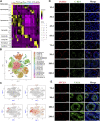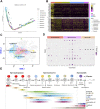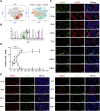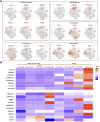Single-cell transcriptomics reveals male germ cells and Sertoli cells developmental patterns in dairy goats
- PMID: 35938151
- PMCID: PMC9355508
- DOI: 10.3389/fcell.2022.944325
Single-cell transcriptomics reveals male germ cells and Sertoli cells developmental patterns in dairy goats
Abstract
Spermatogenesis holds considerable promise for human-assisted reproduction and livestock breeding based on stem cells. It occurs in seminiferous tubules within the testis, which mainly comprise male germ cells and Sertoli cells. While the developmental progression of male germ cells and Sertoli cells has been widely reported in mice, much less is known in other large animal species, including dairy goats. In this study, we present the data of single cell RNA sequencing (scRNA-seq) for 25,373 cells from 45 (pre-puberty), 90 (puberty), and 180-day-old (post-puberty) dairy goat testes. We aimed to identify genes that are associated with key developmental events in male germ cells and Sertoli cells. We examined the development of spermatogenic cells and seminiferous tubules from 15, 30, 45, 60, 75, 90, 180, and 240-day-old buck goat testes. scRNA-seq clustering analysis of testicular cells from pre-puberty, puberty, and post-puberty goat testes revealed several cell types, including cell populations with characteristics of spermatogonia, early spermatocytes, spermatocytes, spermatids, Sertoli cells, Leydig cells, macrophages, and endothelial cells. We mapped the timeline for male germ cells development from spermatogonia to spermatids and identified gene signatures that define spermatogenic cell populations, such as AMH, SOHLH1, INHA, and ACTA2. Importantly, using immunofluorescence staining for different marker proteins (UCHL1, C-KIT, VASA, SOX9, AMH, and PCNA), we explored the proliferative activity and development of male germ cells and Sertoli cells. Moreover, we identified the expression patterns of potential key genes associated with the niche-related key pathways in male germ cells of dairy goats, including testosterone, retinoic acid, PDGF, FGF, and WNT pathways. In summary, our study systematically investigated the elaborate male germ cells and Sertoli cells developmental patterns in dairy goats that have so far remained largely unknown. This information represents a valuable resource for the establishment of goat male reproductive stem cells lines, induction of germ cell differentiation in vitro, and the exploration of sequential cell fate transition for spermatogenesis and testicular development at single-cell resolution.
Keywords: Sertoli cell; dairy goat; single-cell RNA sequencing (scRNA-seq); spermatogenesis; testes.
Copyright © 2022 Ren, Xi, Qiao, Li, Xian, Zhu and Hu.
Conflict of interest statement
The authors declare that the research was conducted in the absence of any commercial or financial relationships that could be construed as a potential conflict of interest.
Figures








Similar articles
-
Sertoli cell and spermatogonial development in pigs.J Anim Sci Biotechnol. 2022 Apr 11;13(1):45. doi: 10.1186/s40104-022-00687-2. J Anim Sci Biotechnol. 2022. PMID: 35399096 Free PMC article.
-
Single-Cell RNA Sequencing Reveals an Atlas of Hezuo Pig Testis Cells.Int J Mol Sci. 2024 Sep 10;25(18):9786. doi: 10.3390/ijms25189786. Int J Mol Sci. 2024. PMID: 39337274 Free PMC article.
-
Irradiation affects germ and somatic cells in prepubertal monkey testis xenografts.Mol Hum Reprod. 2017 Mar 1;23(3):141-154. doi: 10.1093/molehr/gax003. Mol Hum Reprod. 2017. PMID: 28130393
-
Spermatogenesis in nonmammalian vertebrates.Microsc Res Tech. 1995 Dec 15;32(6):459-97. doi: 10.1002/jemt.1070320602. Microsc Res Tech. 1995. PMID: 8605396 Review.
-
Ultrastructure of the aging human testis.J Electron Microsc Tech. 1991 Oct;19(2):241-60. doi: 10.1002/jemt.1060190209. J Electron Microsc Tech. 1991. PMID: 1748904 Review.
Cited by
-
A dynamic transcriptional cell atlas of testes development after birth in Hu sheep.BMC Biol. 2025 Mar 12;23(1):78. doi: 10.1186/s12915-025-02186-y. BMC Biol. 2025. PMID: 40075363 Free PMC article.
-
Transcriptional Profiling of Testis Development in Pre-Sexually-Mature Hezuo Pig.Curr Issues Mol Biol. 2024 Dec 29;47(1):10. doi: 10.3390/cimb47010010. Curr Issues Mol Biol. 2024. PMID: 39852125 Free PMC article.
-
Transcriptome sequencing reveals the effects of circRNA on testicular development and spermatogenesis in Qianbei Ma goats.Front Vet Sci. 2023 Apr 27;10:1167758. doi: 10.3389/fvets.2023.1167758. eCollection 2023. Front Vet Sci. 2023. PMID: 37180060 Free PMC article.
-
Molecular characteristics and regulatory role of insulin-like growth factor 1 gene in testicular Leydig cells of Tibetan sheep.Sci Rep. 2024 Oct 22;14(1):24799. doi: 10.1038/s41598-024-75234-2. Sci Rep. 2024. PMID: 39433555 Free PMC article.
-
Single-Cell RNA Sequencing Reveals an Atlas of Meihua Pig Testis Cells.Animals (Basel). 2025 Mar 5;15(5):752. doi: 10.3390/ani15050752. Animals (Basel). 2025. PMID: 40076035 Free PMC article.
References
LinkOut - more resources
Full Text Sources
Research Materials
Miscellaneous

